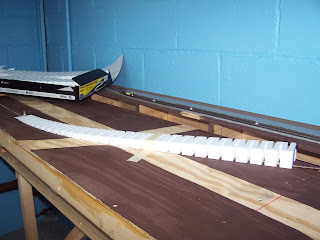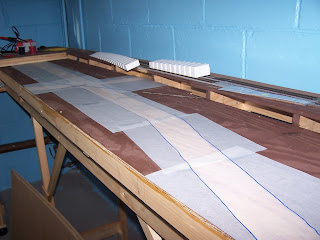 I thought I was done with this section, but the more I looked at the grade I had created the more I realized that the road crossing was at an incline. This would mean that paving the area would require a lot of skill to pour the plaster and keep it consistently thick but also at an angle. I wanted to rush and get the track down and wired, but I decided to first make the area where the track crossed the road. I scraped up the foam incline section and tried to save as much of it as I could. I had used foam-safe adhesive and it didn't want to come up cleanly from the porous ceiling tile. Yes, I know the angle I cut the riser means that area of the track isn't cross-level. It's fine.
I thought I was done with this section, but the more I looked at the grade I had created the more I realized that the road crossing was at an incline. This would mean that paving the area would require a lot of skill to pour the plaster and keep it consistently thick but also at an angle. I wanted to rush and get the track down and wired, but I decided to first make the area where the track crossed the road. I scraped up the foam incline section and tried to save as much of it as I could. I had used foam-safe adhesive and it didn't want to come up cleanly from the porous ceiling tile. Yes, I know the angle I cut the riser means that area of the track isn't cross-level. It's fine. I discovered that the box from Woodland Scenics does comes with a steady grade of 4% and there is only one foam section that takes you from flat to the start of the grade. I thought that it would have thin ramp areas as well as thick spacers to use underneath them. While probably explaining it poorly, the upshot was that you cannot split the box in half and build two 4% grades. You would need to take a middle or upper section and saw the bottom off to get a "starter grade" piece. Since the very thin incline start section shredded, I used cork and cardboard to build another one. Admittedly, it was a little wobbly in places but that only adds to the realism.
I discovered that the box from Woodland Scenics does comes with a steady grade of 4% and there is only one foam section that takes you from flat to the start of the grade. I thought that it would have thin ramp areas as well as thick spacers to use underneath them. While probably explaining it poorly, the upshot was that you cannot split the box in half and build two 4% grades. You would need to take a middle or upper section and saw the bottom off to get a "starter grade" piece. Since the very thin incline start section shredded, I used cork and cardboard to build another one. Admittedly, it was a little wobbly in places but that only adds to the realism. When I laid the track, I let the flextrack float at the bottom of the grade because it naturally took the bend that was most gentle. I could have forced it down and pinned it in place, but the change in elevation would have been too abrupt. After letting the track's caulk cure, I discovered a gap between the bottom of the ties and the ramp so I added more cardboard to fill in the space. When it comes time to ballast the area, I am sure any additional gaps will be hidden. I also soldered the rail joiners on this flex track so that the entire siding is one long piece. That will hopefully smooth out any bumps between pieces on the bends in the grade.
When I laid the track, I let the flextrack float at the bottom of the grade because it naturally took the bend that was most gentle. I could have forced it down and pinned it in place, but the change in elevation would have been too abrupt. After letting the track's caulk cure, I discovered a gap between the bottom of the ties and the ramp so I added more cardboard to fill in the space. When it comes time to ballast the area, I am sure any additional gaps will be hidden. I also soldered the rail joiners on this flex track so that the entire siding is one long piece. That will hopefully smooth out any bumps between pieces on the bends in the grade. The last step was to test the track to ensure that my trains would operate on it properly. This is a siding so most trains wouldn't use it, and those that did would be dropping off or picking up only a few cars at slow speed. Even still, I had to make sure that the couplers held together over the grade and didn't come apart (a runaway train down the grade would certainly lead to a crash. My testing train consisted of two long (probably 75 scale feet) Like Like Amtrak coaches. They are longer than normal 50' boxcars that will be run on this track, and if the coaches can make it, anything can. The couplers shifted vertically about a 1/4 knuckle, which is acceptable to me.
The last step was to test the track to ensure that my trains would operate on it properly. This is a siding so most trains wouldn't use it, and those that did would be dropping off or picking up only a few cars at slow speed. Even still, I had to make sure that the couplers held together over the grade and didn't come apart (a runaway train down the grade would certainly lead to a crash. My testing train consisted of two long (probably 75 scale feet) Like Like Amtrak coaches. They are longer than normal 50' boxcars that will be run on this track, and if the coaches can make it, anything can. The couplers shifted vertically about a 1/4 knuckle, which is acceptable to me.Four more pairs of feeder wires, which made a total of seven for this section, finished up the hard stuff. I need to insert wooden ties in the gaps but that will be pretty easy.






























